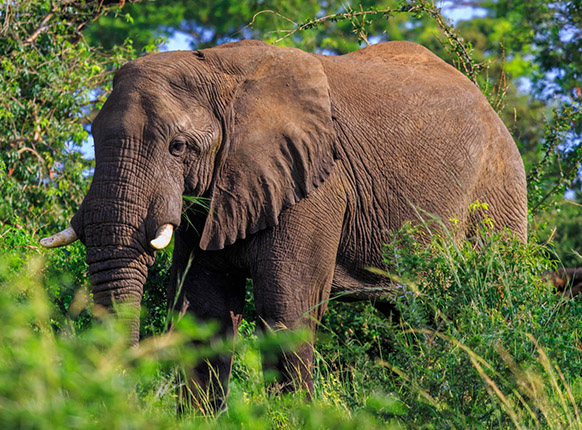- September 9, 2023
- Posted by: Editor2
- Category: Blog
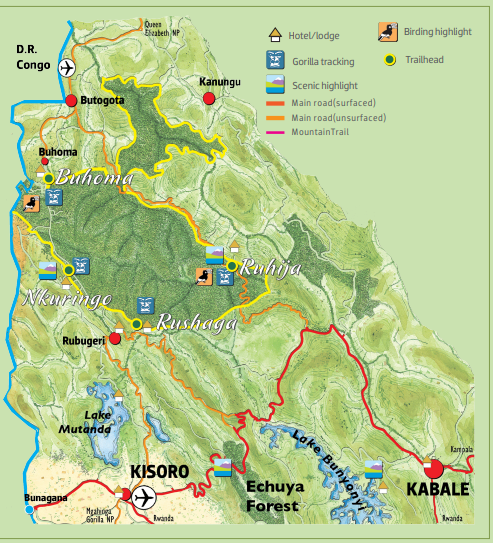
Gorilla trekking sectors that you must visit in Bwindi Impenetrable National Park
Bwindi Impenetrable National Park is a UNESCO World Heritage Site located in southwestern Uganda. Bwindi has four sectors all best for gorilla trekking from which you must choose one at ago. It is home to over half of the world’s remaining population of mountain gorillas. This makes it one of the most important conservation areas in the world for this critically endangered species.
Within Bwindi, there are several sectors that have been designated for gorilla trekking. Gorilla trekking is the main way that visitors can observe and interact with the gorillas in their natural habitat. These sectors in Bwindi offers a unique gorilla trekking experience, with different terrain, vegetation, and gorilla groups to observe. Visitors must obtain a gorilla trekking permit to visit any of these sectors in Bwindi. Permits are limited to a certain number of visitors per day to minimize disturbance to the gorillas and their habitat.
Having that in mind, let us dive into the gorilla trekking sectors in Bwindi Impenetrable National Park;
Buhoma sector
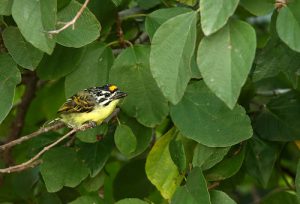
Buhoma Sector is one of the four sectors in Bwindi Impenetrable National Park designated for gorilla trekking. It is located in the northern part of the park and is the oldest and most popular sector for gorilla trekking in Bwindi.
Buhoma Sector is home to five habituated gorilla groups that are available for tourism: Mubare, Habinyanja, Rushegura, Muyambi, and Katwe. Each of these groups has its own distinct characteristics and behaviors. It provides visitors with a unique gorilla trekking experience.
To trek gorillas in the Buhoma Sector, visitors must first obtain a permit. The permits are limited to a maximum of eight visitors per gorilla group per day. Permits can be purchased in advance through a tour operator.
The trekking experience in the Buhoma Sector typically involves a hike through the forest. It lasts 2 to 8 hours depending on the location of the gorilla group. During the trek, visitors will be accompanied by a guide and trackers who will help locate the gorillas. These also ensure a safe and respectful interaction.
How do I obtain a permit to trek gorillas in the Sectors of Bwindi?
To obtain a permit to trek gorillas in the Buhoma Sector of Bwindi Impenetrable National Park, you need to follow these steps:
- Contact a registered and reputable tour operator or travel agency in Uganda that offers gorilla trekking packages. They will assist you in securing a permit and making all the necessary arrangements for your trip. Love Uganda Safaris and Tours is one of the suggestions for tour operators in Uganda. Send your gorilla trekking inquiry Now.
- Provide the tour operator with your preferred dates for the trekking and the number of people in your group. Note that only eight permits are available per day for each gorilla group. It is best to book well in advance to secure your preferred dates.
- The tour operator will then apply for the permit on your behalf from the Uganda Wildlife Authority (UWA). They will require a copy of your passport details and the full payment for the permit.
- Once the UWA confirms the availability of the permits, the tour operator will purchase them. They will send you a confirmation with all the details of your trek, including the date, time, and meeting point.
- On the day of the trek, you will need to present your permit at the park headquarters in the respective sectors and attend a pre-trek briefing. The briefing will provide you with important information about gorilla trekking etiquette and safety guidelines.
- After the briefing, you will be assigned a gorilla group and a guide, and you will begin your trek into the forest to find the gorillas.
It is important to note that gorilla trekking permits are in high demand. They sell out quickly, especially during peak season. Therefore, it is advisable to book your permit well in advance to avoid disappointment.
What is the peak season for gorilla trekking in Buhoma Sector?
The peak season for gorilla trekking in the Buhoma Sector of Bwindi Impenetrable National Park is from June to September and from December to February. During these months, the weather is generally drier, which makes hiking conditions more favorable.
Additionally, these months coincide with the main holiday periods in many countries. This means that demand for gorilla trekking permits is usually higher, and availability can be limited. It is therefore advisable to book your permit well in advance if you plan to visit during the peak season.
However, it is worth noting that gorilla trekking in the Buhoma Sector is possible throughout the year. And each season has its own unique advantages. For example, the rainy season from March to May and from October to November can be a good time for photographers. The forests are lush and green, and there are fewer visitors.
Generally, the best time to visit the Buhoma Sector for gorilla trekking will depend on your personal preferences and travel plans.
What are the advantages of visiting the Buhoma Sector during the rainy season?
While the peak season for gorilla trekking in the Buhoma Sector of Bwindi Impenetrable National Park is from June to September and from December to February, there are some advantages to visiting during the rainy season from March to May and from October to November.
Here are some of the advantages:
Lush and green vegetation: During the rainy season, the forests in the Buhoma Sector are lush and green. This provides a beautiful backdrop for trekking and wildlife viewing. The rain also brings out the flowers, which can make for some spectacular photo opportunities.
Fewer visitors: The rainy season is considered the low season for tourism. There are usually fewer visitors in the Buhoma Sector during this time. This can mean that you have a better chance of securing a permit and that you may have a more intimate gorilla trekking experience.
Lower prices: Accommodation and tour prices are often lower during the rainy season. This makes it a more affordable time to visit the Buhoma Sector.
Wildlife sightings: The rainy season can be a great time to see other wildlife in addition to the gorillas. Many animals come out to feed in the open areas after the rain, and bird watching can be particularly good during this time.
Cultural experiences: The rainy season is a good time to experience the local culture and traditions of the communities living around the Buhoma Sector. Many cultural events and festivals take place during this time, providing an opportunity to learn more about the people and their way of life.
Overall, while the rainy season may have its challenges, it can also provide a unique and rewarding experience for visitors to the Buhoma Sector.
What are some of the challenges of visiting the Buhoma Sector during the rainy season?
While there are some advantages to visiting the Buhoma Sector of Bwindi Impenetrable National Park during the rainy season from March to May and from October to November, there are also some challenges that visitors should be aware of. Here are some of the challenges:
Slippery and muddy trails: The rain can make the trails in the Buhoma Sector slippery and muddy, which can make trekking more difficult and potentially dangerous. Visitors should be prepared for challenging hiking conditions and wear appropriate footwear.
Limited visibility: The rain and mist can reduce visibility in the forest, making it more difficult to see the gorillas and other wildlife. This can also make photography more challenging.
Increased risk of disease: The rainy season is also a time when mosquitoes are more prevalent, which can increase the risk of contracting diseases such as malaria. Visitors should take precautions to protect themselves from mosquito bites, such as wearing long sleeves and pants, using insect repellent, and sleeping under mosquito nets.
Road conditions: The rain can also make the roads leading to the Buhoma Sector more challenging to navigate, particularly in rural areas where infrastructure is limited. Visitors should be prepared for longer travel times and potentially bumpy roads.
Limited availability of services: Because the rainy season is the low season for tourism, some lodges and tour operators may have reduced services or even closed temporarily. Visitors should check ahead to ensure that their planned accommodations and activities will be available during their visit.
Overall, while the rainy season can present some challenges, with proper preparation and planning, visitors can still have a rewarding and enjoyable experience in the Buhoma Sector.
Nkuringo sector
Nkuringo Sector is one of the four sectors in Bwindi Impenetrable National Park designated for gorilla trekking. It is located in the southern part of the park and is home to one habituated gorilla group that is available for tourism.
The Nkuringo gorilla group is known for its large size and impressive silverback, which makes for a memorable trekking experience. The group consists of around 19 gorillas, including several juveniles and infants, and is led by a dominant silverback named Rafiki.
To trek gorillas in the Nkuringo Sector, visitors must first obtain a permit from the Uganda Wildlife Authority (UWA). The permits are limited to a maximum of eight visitors per day for the Nkuringo group, and they can be purchased in advance through a tour operator or directly from the UWA.
The trekking experience in Nkuringo Sector typically involves a hike through the forest, lasting anywhere from 2 to 8 hours depending on the location of the gorilla group. During the trek, visitors will be accompanied by a guide and trackers who will help locate the gorillas and ensure a safe and respectful interaction.
Nkuringo Sector offers a unique and unforgettable opportunity to observe and interact with endangered mountain gorillas in their natural habitat. It is a less visited sector compared to others in Bwindi Impenetrable National Park, which can make for a more intimate and exclusive experience.
What is the best time of year to visit the Nkuringo Sector?
The best time of year to visit the Nkuringo Sector for gorilla trekking is during the dry season, which runs from June to September and from December to February. During these months, the weather is generally drier, which makes hiking conditions more favorable. The dry season also coincides with the peak season for tourism, which means that demand for permits is high, and availability can be limited. It’s therefore advisable to book your permit well in advance if you plan to visit during this time.
However, it is worth noting that gorilla trekking in the Nkuringo Sector is possible throughout the year, and each season has its own unique advantages. For example, the rainy season from March to May and from October to November can be a good time for photographers, as the forests are lush and green, and there are fewer visitors.
What are the chances of seeing gorillas during the rainy season?
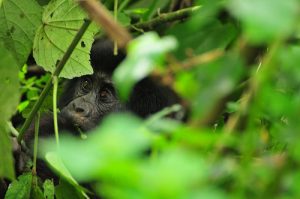
The chances of seeing gorillas during the rainy season in the Nkuringo Sector of Bwindi Impenetrable National Park are the same as during the dry season. While the rain may make the hiking conditions more challenging, the gorillas are still present in the forest, and trackers are able to locate them for visitors.
In fact, some visitors prefer trekking during the rainy season because the forests are lush and green, and there are fewer visitors, which can make for a more intimate and exclusive gorilla trekking experience. Additionally, the rain can bring out other wildlife, such as birds and monkeys, which can make for a more diverse and interesting wildlife viewing experience.
It is important to note that the weather in Bwindi Impenetrable National Park can be unpredictable, and rain can occur at any time of year. Visitors should be prepared for the possibility of rain and bring appropriate gear, such as a waterproof jacket and sturdy hiking boots.
Overall, while the rainy season may present some challenges, visitors still have a good chance of seeing gorillas in the Nkuringo Sector with the help of experienced guides and trackers.
What gear should I bring for a gorilla trek during the rainy season?
If you are planning a gorilla trek in the Nkuringo Sector of Bwindi Impenetrable National Park during the rainy season, it’s important to come well-prepared with the right gear. Here are some of the essential items to bring:
Waterproof jacket: A good quality waterproof jacket is essential for staying dry during the rain. Look for a jacket that is breathable, lightweight, and able to withstand heavy rain.
Waterproof pants: In addition to a waterproof jacket, you should also bring waterproof pants to keep your legs dry during the trek.
Sturdy hiking boots: The trails in the Nkuringo Sector can be slippery and muddy during the rainy season, so it is important to wear sturdy hiking boots with good traction.
Long-sleeved shirts and pants: Long-sleeved shirts and pants can help protect your skin from scratches and insect bites during the trek.
Insect repellent: Mosquitoes and other insects are more prevalent during the rainy season, so it’s important to bring a good quality insect repellent to protect yourself from bites.
Hat and sunglasses: A hat and sunglasses can help protect your face and eyes from the sun and rain.
Small backpack: A small backpack can be useful for carrying water, snacks, and other essentials during the trek.
Camera and extra batteries: Don’t forget to bring a camera to capture the amazing moments during the gorilla trek. It is also a good idea to bring extra batteries or a portable charger to ensure that your camera is always charged.
Generally, by coming prepared with the right gear, you can ensure a safe, comfortable, and enjoyable gorilla trekking experience in the Nkuringo Sector during the rainy season.
Ruhija sector
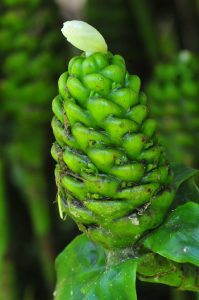
Ruhija Sector is one of the four sectors in Bwindi Impenetrable National Park designated for gorilla trekking. It is located in the eastern part of the park and is home to three habituated gorilla groups that are available for tourism: Oruzogo, Bitukura, and Kyaguliro.
Ruhija Sector is known for its stunning scenery, including panoramic views of the Virunga Mountains. It is also home to a variety of other wildlife, including several species of primates, birds, and butterflies.
To trek gorillas in the Ruhija Sector, visitors must first obtain a permit from the Uganda Wildlife Authority (UWA). The permits are limited to a maximum of eight visitors per gorilla group per day, and they can be purchased in advance through a tour operator or directly from the UWA.
What is the best time of year to visit the Ruhija Sector?
The best time of year to visit the Ruhija Sector of Bwindi Impenetrable National Park for gorilla trekking is during the dry season, which runs from June to September and from December to February. During these months, the weather is generally drier, which makes hiking conditions more favorable. The dry season also coincides with the peak season for tourism. It is therefore advisable to book your permit well in advance.
However, it is worth noting that gorilla trekking in the Ruhija Sector is possible throughout the year. Each season has its own unique advantages. For example, the rainy season is a good time for photographers. The forests are lush and green, and there are fewer visitors.
The rainy season can also be a good time to see other wildlife, such as birds and monkeys, as they are more active during this time. Additionally, lodges and tour operators may offer lower rates during the low season.
Overall, the best time to visit the Ruhija Sector for gorilla trekking will depend on your personal preferences and travel plans. It is a good idea to consult with a local tour operator or travel agency to determine the best time to visit based on your interests and priorities.
What are some other activities to do in the Ruhija Sector besides gorilla trekking?
While gorilla trekking is the main attraction in the Ruhija Sector of Bwindi Impenetrable National Park, there are also several other activities to do in the area. Here are some of the top activities:
Nature walks: Ruhija Sector offers several nature trails through the forest, which provide an opportunity to observe other wildlife, such as birds, monkeys, and butterflies, and to learn about the local flora and fauna.
Cultural experiences: The nearby Batwa community offers cultural experiences, such as traditional dancing, storytelling, and visits to local homes. This can be a great way to learn about the local culture and way of life.
Bird watching: Ruhija Sector is home to over 350 species of birds, making it a paradise for birdwatchers. Special bird-watching walks can be arranged with experienced guides.
Village walks: Visitors can take a guided walk through the nearby villages. This enables them learn about the local customs and way of life. This can be a great way to interact with the local people and get a glimpse into their daily lives.
Waterfall hikes: There are several waterfalls in the area that can be reached through short hikes. These hikes offer stunning views of the surrounding landscape and provide a refreshing break from the heat.
Overall, gorilla trekking is the main attraction in the Ruhija Sector. However, there are several other activities to do in the area that can provide a more complete and diverse experience of the local culture and environment.
What is the best time of day to go on a nature walk?
The best time of day to go on a nature walk in the Ruhija Sector of Bwindi Impenetrable National Park depends on your personal preferences and interests. Here are some things to consider:
Temperature: The temperature is typically cooler in the morning and evening, which can make for a more comfortable walking experience. Midday temperatures can be hot and uncomfortable, particularly during the dry season.
Wildlife activity: Many animals, particularly birds, are most active in the early morning and late afternoon. This makes it ideal for wildlife viewing. Additionally, some animals, such as primates, may be more active during the cooler parts of the day.
Lighting: The lighting can be particularly beautiful during the early morning and late afternoon, providing ideal conditions for photography.
Schedule: Your schedule and other planned activities may impact the best time of day for a nature walk. For example, if you are planning a gorilla trek in the morning, a nature walk in the afternoon may be a good option.
Rushaga sector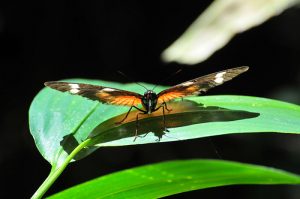
Rushaga Sector is one of the four sectors in Bwindi Impenetrable National Park designated for gorilla trekking. It is located in the southern part of the park. It is also home to five habituated gorilla groups that are available for trekking. These are; Nshongi, Mishaya, Kahungye, Busingye, and Bweza.
Rushaga Sector is known for its rugged terrain and stunning views of the surrounding landscape. It is also home to a variety of other wildlife, including several species of primates, birds, and butterflies.
To trek gorillas in Rushaga Sector, visitors must first obtain a permit from the Uganda Wildlife Authority (UWA). The permits are limited to a maximum of eight visitors per gorilla group per day.
The trekking experience in Rushaga Sector typically involves a hike through the forest. The trek lasts anywhere from 2 to 8 hours depending on the location of the gorilla group. During the trek, visitors will be accompanied by a guide and trackers. He or she will help locate the gorillas and ensure a safe and respectful interaction.
What is the best time of year to visit Rushaga Sector?
The best time of year to visit Rushaga Sector of Bwindi for gorilla trekking is during the dry season. This runs from June to September and from December to February. During these months, the weather is generally drier, which makes hiking conditions more favorable. The dry season also coincides with the peak season for tourism. This means that the demand for permits is high, and availability can be limited. It is therefore advisable to book your permit well in advance if you plan to visit during this time.
However, it is worth noting that gorilla trekking in Rushaga Sector is possible throughout the year. Each season has its own unique advantages. For example, the rainy season is a good time for photographers. During this time, the forests are lush and green, and there are fewer visitors.
The rainy season can also be a good time to see other wildlife, such as birds and monkeys, as they are more active during this time. Additionally, lodges and tour operators may offer lower rates during the low season.
Generally, the best time to visit Rushaga Sector for gorilla trekking will depend on your personal preferences and travel plans. It is a good idea to consult with a local tour operator or travel agency to determine the best time to visit based on your interests and priorities.
Which sector is easy for persons with disabilities?
Gorilla trekking in Bwindi Impenetrable National Park can be a challenging activity. However, there are some sectors that may be more accessible for persons with disabilities. The Ruhija Sector is considered to be the most accessible sector for gorilla trekking. The sector has relatively gentle terrain and shorter hiking distances compared to other sectors.
In addition to gorilla trekking, Ruhija Sector also offers other activities that may be more accessible for persons with disabilities. These include; bird watching, cultural experiences, and nature walks. There are also several lodges in the area that offer accessible accommodations and facilities.
What are the requirements for obtaining special permits from the Uganda Wildlife Authority?
Some of the requirements that may be necessary to obtain a special permit include:
Medical certification: Visitors may need to provide medical certification from a licensed physician or medical professional. This should indicate their specific disability or limitation and their ability to participate in the activity.
Accommodation requirements: Visitors may need to provide information about their specific accommodation requirements, such as wheelchair-accessible rooms or facilities.
Support staff: Visitors may need to bring their own support staff, such as a caregiver or interpreter. In some cases, the UWA may be able to provide additional support staff, depending on availability and specific needs.
Equipment requirements: Visitors may need to bring their own specialized equipment, such as a mobility aid or hearing aid.
Additional fees: Depending on the specific needs and requirements, visitors may be required to pay additional fees for special permits.
Are there any other national parks in Uganda that offer gorilla trekking?
Yes, there is one other national park in Uganda that offers gorilla trekking. That is Mgahinga Gorilla National Park. The park is located in southwestern Uganda, bordering Rwanda and the DRC. It is also part of the larger Virunga Conservation Area.
Mgahinga Gorilla National Park is home to one habituated gorilla group. The Nyakagezi group, which can be trekked by visitors with permits. In addition to gorilla trekking, the park offers other activities. These include; hiking, bird watching, and cultural experiences with the local Batwa people.
Compared to Bwindi Impenetrable National Park, Mgahinga Gorilla National Park is smaller. It also has fewer habituated gorilla groups available for tourism. However, it offers a unique and intimate gorilla trekking experience in a stunning and remote setting.
It is important to note that permits for gorilla trekking in Mgahinga Gorilla National Park are limited. They should be booked in advance through a tour operator or directly from the Uganda Wildlife Authority (UWA).
In conclusion, gorilla trekking sectors of Bwindi Impenetrable National Park offer visitors a unique and unforgettable experience. Are you interested in gorilla trekking, bird watching, or cultural immersion? There is something for everyone to enjoy in this beautiful and bio-diverse park.
 info@thegorillatrekking.com
info@thegorillatrekking.com  +256 392 177 127
+256 392 177 127 
